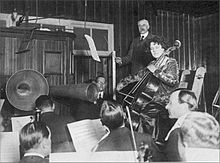Cello Concerto (Elgar)

The cello concerto in E minor, op. 85 by the English composer Edward Elgar (1857–1934), premiered in 1919, comes from his last creative phase.
Origin, premiere and reception
Two solo concertos by Edward Elgar have survived: the one for violin was written in 1910, nine years before his concert for cello (there are also sketches for a piano concerto). In 1917 Edward Elgar moved from London to the Brinkwells country house near Fittleworth in Sussex . In the spring of 1918 he had to undergo an almond operation and immediately after returning to his home wrote down the main theme of his later cello concerto. Initially, however, he wrote three chamber music works: the violin sonata in e minor, op. 82, the string quartet in e minor, op. 83, and the piano quintet in a minor, op. 84. In 1919 he turned to composing the cello concerto. The intended soloist was Felix Salmond , who had participated in the premiere of the string quartet and also advised Elgar on technical issues relating to the concert.
The cello concerto, dedicated to the literary and art critic Sidney Colvin and his wife Frances, premiered on October 27, 1919 in London's Queen's Hall under Elgar's direction with the London Symphony Orchestra . The performance suffered from the fact that Albert Coates , the conductor of the rest of the program, had taken up most of the rehearsal time for Le Poème de l'Extase by Alexander Scriabin . Ernest Newman , critic of the Observer , wrote: “There have been rumors about during the week of inadequate rehearsal. Whatever the explanation, the sad fact remains that never, in all probability, has so great an orchestra made so lamentable an exhibition of itself. ... The work itself is lovely stuff, very simple - that pregnant simplicity that has come upon Elgar's music in the last couple of years - but with a profound wisdom and beauty underlying its simplicity. ”(“ During the week there were rumors about Inadequate rehearsals. Whatever the reason, the unfortunate fact remains that probably never before such an important orchestra has given such a pathetic self-expression […] The work itself is wonderful, very simple - from the meaningful simplicity of Elgar's music of the last few years - but of a profound wisdom and beauty that underlies its simplicity ”).

In December 1919 a first, but shortened, recording was made with the cellist Beatrice Harrison under the direction of Elgar, and in 1928 a complete recording with the same performers. The first print appeared in 1921 by Novello and Company . The autograph of the work is in the Royal College of Music . Elgar's cello concerto, which had been rarely played for decades, gained broader fame in 1965 through a recording of the then twenty-year-old cellist Jacqueline du Pré under the direction of John Barbirolli , who had already participated as an orchestral cellist at the premiere, which continues to set standards today .
Cast and characterization
In addition to the solo violoncello , the score provides for the following orchestral scoring :
2 flutes (2nd also piccolo , ad libitum), 2 oboes , 2 clarinets , 2 bassoons , 4 horns , 2 trumpets , 3 trombones , tuba (ad libitum), 3 timpani and strings .
The performance lasts about 30 minutes. The four movements of the concert have the following tempo markings:
- Adagio - Moderato
- Lento - Allegro molto
- adagio
- Allegro - Moderato - Allegro, ma non troppo - Poco più lento
Edward Elgar's cello concerto, which was characterized by predominantly melancholy moods, was written by the composer at the end of the score with the words “Finis. RIP “His Opus 85 was to be Elgar's last completed work, apart from a few transcriptions, arrangements and occasional pieces.
The first movement begins with a recitative-like introduction to the solo cello, before the orchestra - initially in the violas - intones the main theme moderato in 9/8 time, which is based on a single rhythmic cell and is repeated several times.

In the middle section of the movement, the keys of E minor and E major are used in contrasts. After a recapitulation of the main theme, the movement fades away softly in a series of pizzicati , which lead directly to the second movement, which takes on the role of the scherzo . Its main theme, characterized by a lively sixteenth-note sequence, is interrupted several times by a cantable second theme in E flat major.
The third movement dispenses with brass and comprises only 60 bars, the continuous melodic line in B flat major spinning the solo cello almost uninterruptedly like a “song without words”. The finale is the most extensive movement in the work. The main theme, voiced by the cello after a short, quick orchestral introduction, bears the performance designation “Nobilmente” characteristic of Elgar and is later adopted by the entire orchestra. Towards the end, the melody of the Adagio and then the cello recitative from the beginning of the first movement appear as reminiscences, before the movement is driven to the almost abrupt end with the full orchestral sound.
Individual evidence
- ^ Scan of Ernest Newman's newspaper review, The Observer, "Music of the Week", November 2, 1919
- ^ Sarah Kirkup: Jacqueline du Pré and the Elgar Cello Concerto - 50 years on . Gramophone, May 12, 2015
- ↑ Introduction to Declan Kennedy (Engl.)
literature
- Richard Clarke (Ed.): Elgar: Cello Concerto E minor op.85, Eulenburg, London etc., 2012 (pocket score with foreword by Diana McVeagh)
Web links
- Cello Concerto, Elgar : Sheet Music and Audio Files in the International Music Score Library Project
- Program notes for the premiere in 1919 (Engl.)
- Work introduction Blair Johnston, allmusic.com (Engl.)
- Introduction to the work Declan Kennedy (Engl.)

